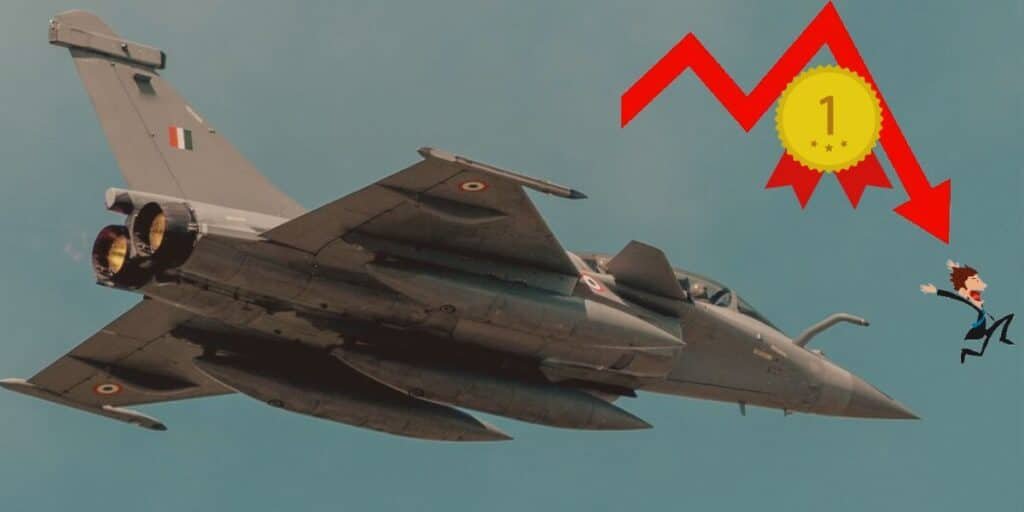Webdesk: The Indian Air Force (IAF) has received heavy criticism after a report indicates that this air force has lost more than 550 planes during crashes in the last 30 years which is a very high number compared to other air units across the world.
The Indian Air Force has reportedly become the first air force in the world to crash over 550 aircraft in the past 30 years.
In May 2025, tensions between Pakistan and India escalated sharply after a deadly attack in Indian Illegally Occupied Jammu and Kashmir (IIOJK), which killed 26 tourists. India blamed Pakistan without providing proof, leading to diplomatic fallout.
On May 7, the Indian Air Force carried out an unprovoked strike on civilian areas in Pakistan, prompting a strong response from the Pakistan Air Force, which shot down at least six Indian jets, including three Rafales.
India launched further strikes on military targets on May 9–10, to which Pakistan responded with a major operation targeting Indian military sites. A ceasefire was announced on May 10 after international pressure.
Despite the Indian government’s denial, statements from Indian defence officials hint at more serious losses than admitted, showing confusion and a lack of unity in India’s political and military leadership.
#BREAKING: Indian Air Force becomes first air force in the world to crash 550+ aircraft in the last 30 years. pic.twitter.com/vSIwbAuzmY
— Ironclad (@NavCom24) July 13, 2025
In the last three decades, the Indian Air Force (IAF) has recorded too many aviation accidents in which more than 530 aircraft and at least 152 pilots have been lost.
#BREAKING: Indian Air Force becomes first air force in the world to crash 550+ aircraft in the last 30 years.#India #Airforce #Wimbledon #ENGvIND #englot pic.twitter.com/uQs3ekccIj
— Abdullah Jamil (@AbduullahJamil) July 13, 2025
The May tensions between India and Pakistan also led to the now-famous 6–0 scoreline in favour of the Pakistan Air Force.
Picking up where I left off – PAF 6 – IAF 0 🔥🇵🇰 pic.twitter.com/umAwRHcqBJ
— Mansoor Ahmed Qureshi (@MansurQr) July 13, 2025
India’s military confirmed for the first time that it lost an unspecified number of fighter jets in clashes with Pakistan in May.
— Bloomberg TV (@BloombergTV) May 31, 2025
Anil Chauhan, chief of defense staff of the Indian Armed Forces, spoke to Bloomberg TV on Saturday, while attending the Shangri-La Dialogue in… pic.twitter.com/9y3GW6WJfn
A legacy of neglect: Why the Indian Air Force keeps losing aircraft
As Indian aviation analyst Anchit Gupta pieced together based on Indian parliament Q&A archives dating back to 1989-90, these figures indicate how extreme and deep-seated the problems of safety in the IAF have been.
The magnitude of such losses is worrying and difficult to ignore because the airline operates under harsh conditions and maintains a huge number of ageing aircraft.
Although the non-combat accidents and losses are a consequence of the operation associated with military aviation, the high level of losses leads to grave doubts regarding the maintenance standards, the quality of training pilots and the safety of ageing aircraft in the IAF fleet.
IAF has had a troubling record in aviation history. No other air force in the world has recorded such a high number of peacetime aircraft crashes in the same period. This troubling statistic reflects deep-rooted issues in fleet modernisation and logistics management.
Gupta’s research, which he shared on Twitter (now X) in 2022, paints a questionable picture.
The statistics indicate that the IAF lost hundreds of a variety of aircraft, both fighters, trainers, helicopters and transport aircraft, in the majority of cases, not in combat circumstances.
It has also been very costly in terms of human life with more than 150 pilots having been killed in their normal operations.
This was particularly common in the 1990s when the IAF had been averaging 20 to 30 accidents annually. Many of them were with the obsolescent MiG-21, popularly known as the “flying coffin” due to the large number of accidents.
Many of the aircraft involved were decades old, with limited upgrades and diminishing airworthiness, further exacerbated by insufficient indigenous production capabilities and a patchwork of foreign-sourced equipment.
Many lives have been lost plenty of assets have been ruined. The human and financial cost of these crashes has been enormous. Dozens of trained pilots have lost their lives, and billions of dollars in military hardware have been reduced to wreckage.
While the IAF has initiated inquiries after each incident, few of these have resulted in systemic changes, prompting critics to question the effectiveness of internal safety audits and governmental oversight.
Some crashes have stood out in recent memory. In July 2022, a MiG-21 trainer went down near Barmer, Rajasthan, killing Wing Commander M. Rana and Flight Lieutenant Advitya Bal.
The year before, similar tragedies claimed the lives of Squadron Leader Abhinav Choudhary and Group Captain Ashish Gupta. These accidents raised serious questions about why aircraft designed in the 1960s were still flying in 21st-century skies, long after their planned retirement.
The MiG-21’s poor safety record is no secret, despite this, delays in modernising the fleet have kept these ageing jets in service far longer than they should have. While IAF officials have defended the aircraft’s performance when well maintained, its age and outdated design have clearly been major factors in many fatal crashes.
Critics argue that these improvements don’t erase the deeper problems. A long-standing dependence on ageing Soviet-era technology, slow progress in defence procurement, and years of underinvestment in domestic aircraft development have all left the IAF struggling to modernise.
something is really wrong with the IAF. losing four fighter jets in crashes and losing fighters to PAF kills just in one night. even if we take four crashes reported by the Indian media on night 6/7, that's eight. if we take 6, it's 10. IAF really needs to shape up. pic.twitter.com/ZZHe8H7TdS
— EH (@ejazhaider) July 10, 2025
Another factor is the Pilot error, which is continuously brought on by challenging flying conditions, in addition to the challenge of handling an antiquated aircraft. Meanwhile, mechanical faults and system failures have repeatedly led to problems.
While the IAF has made some strides in reducing crashes, the past three decades offer a sobering look at the risks of flying with an ageing fleet and the cost of slow defence reforms. The numbers speak for themselves, and they reflect a legacy of neglect that continues to cost lives.
Symbol of operational incompetence or resource neglect?
This dismal performance could not simply evade the bad luck notices or the costs of heavy operational requirements. It reveals no definite policy regarding defence acquisition and inadequate funding to train pilots using simulators along with a continuous slackness in changing the old weaponry.
For the last two months, India’s been busy fabricating narratives to hide the loss of its Rafales and soldier casualties, Lets not forget how much damage we caused them.
— Zard si Gana (@ZardSi) July 13, 2025
The PAF humbled them with a score of 6-0 🇵🇰 pic.twitter.com/21FeL0R5i6
Failure to implement urgent structural reforms will not only put the IAF at risk of failing to be operationally ready but it will also compromise the morale of the personnel.
Read more: Modi government faces backlash over Hindi language push






